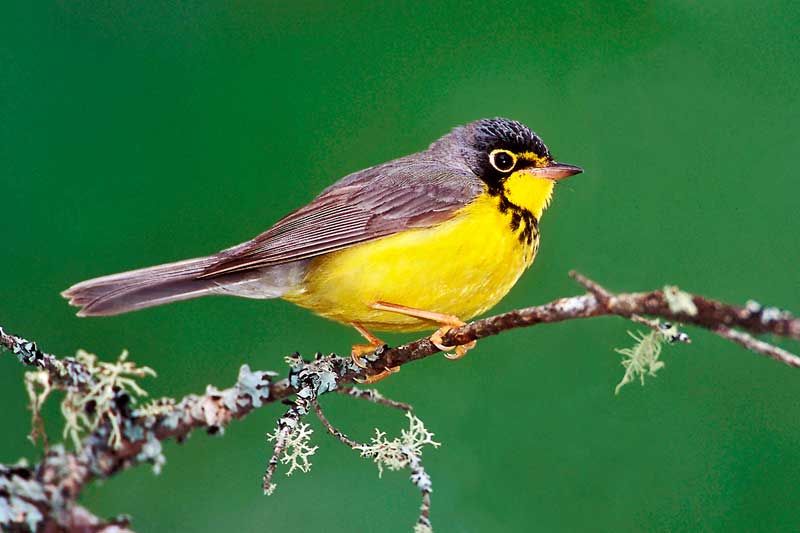Jul 17, 2014
Ian Tanner, Natural Heritage Education Leader
The unique geography of Bon Echo Provincial Park makes it a great place to view our avian friends throughout the year.
Peregrine Falcons may be the most notable birds that reside in Bon Echo. Twenty years ago Peregrine Falcons were re-introduced to Mazinaw Lake by Natural Heritage Education Coordinator, Denise Wilkins. During the spring and summer months Mazinaw Lake echoes with their distinctive kak-kak-kak calls. They can be seen flying frequently along the edge of the cliff or perched high on a tree surveying the skies. The falcons at Bon Echo often prey on Blue Jays and Ring-billed Gulls, diving from high in the air and capturing their food on the wing. When the Peregrine Falcons migrate south for the winter there is a marked increase in gulls at the Narrows and the beaches.
Another bird of prey that dwells in Bon Echo is the Barred Owl. Most people who spend a night or two in the Park will hear this bird call “Who cooks for you...who cooks for you all”. Barred Owls are among the most vocal of owls and are also quite common although they are notoriously difficult to spot during the day. A unique feature about owls is a peculiarity of their feathers. The wing feathers are very soft and therefore are not efficient for flying speed. However, they produce a quieter flight reducing the chance of being heard by their prey. Another unique feature is the location of an owl’s ears. One is located higher on the owl’s head than the other, allowing them to triangulate the position of their next meal far more accurately than were their ears to be symmetrical.
If you are heading out to Joeperry Lake keep your eyes peeled for Ospreys. These hawks have a diet that consists almost entirely of fish and they will hover above the water before plunging in to grab a meal. Another bird that spends its life looking for fish is the Belted Kingfisher. These brilliant blue birds perch on branches above the water and dive for small minnows and frogs. The Common Loon is also present in Bon Echo’s waters. While they live on Mazinaw Lake, your best chance to see them will be on Joeperry, Bon Echo, or Kishkebus Lakes. These birds are uniquely adapted for pursuing fish underwater and can hold their breath for several minutes, travelling hundreds of metres while submerged.
Barn Swallows also call Mazinaw Rock home. These aerial acrobats are now a threatened species due to the decline in foraging habitat, loss of available nesting sites, and pesticide spraying reducing the number of insects needed for food. These birds however can be seen most days at the Narrows. They swoop and dive catching insects just above the surface of the water. If you watch carefully you can see them drink while airborne, gliding close to the water and scooping up a mouthful. These small birds are great builders, nesting directly on the cliff. They build their nests by carrying mud, a little at a time from nearby streams and ponds then mixing it with saliva and lining it with moss and feathers.
A number of woodpeckers can be seen among the trees at Bon Echo. The smallest is the Downy Woodpecker, a black and white bird with males sporting a tiny red patch on the head. It has a long barbed tongue and glue-like saliva which help it catch insects. The largest is the Crow sized Pileated Woodpecker which is mostly black with white flashes on the neck and a flaming red crest on its head. Woodpeckers chisel holes in trees to reach the insects and grubs living in them. Large rectangular holes are telltale signs of Pileated Woodpeckers. A woodpecker can be identified by its distinctive “swooping” flight. Woodpeckers will flap their wings once or twice then fold them in, resulting in a wave-like flight.
The Park is also home to a plethora of different warblers and songbirds including White- throated Sparrows, Common Redpolls, and occasionally Scarlet Tanagers. The Cliff Top Trail is home to the Prairie Warbler. These birds are olive-coloured above with bright yellow below and black spots and streaks along their sides. Prairie Warblers prefer hot, dry environments, nest in juniper bushes on Mazinaw Rock, and are at the northern edge of their breeding habitat. Many of these birds call the Park home throughout the summer but can be difficult to spot among the leaves and undergrowth. For this reason I recommend familiarizing yourself with a few different birdcalls, such as the calls of the Red-eyed Vireo, the American Robin, and the Wood Thrush. More may be added as you become familiar with a few..
Fall is an exciting time to look for birds in Bon Echo. With the changing weather not only are the leaves disappearing but many birds are also migrating through the Park on their way to wintering habitats. Last fall we were lucky enough to spot a Red-throated Grebe swimming in Mazinaw Lake, as well as Broad-winged Hawks, Ruby-throated Hummingbirds, and Wood Ducks.
Whether you are an avid birdwatcher or someone just curious to see how many bird species you can spot, bring along a field guide and binoculars on your next visit to Bon Echo. You’ll be rewarded by a remarkable variety of sightings and songs.
More Stories
- Province clarifies stance - Says Private Well Water Testing Will Continue
- Frontenac County Stays Internal for CAO - Appoints Kevin Farrell
- Addington Highlands Tax Bill Going Up 6.93%
- Perth Road United Church Donation to The Grace Centre
- 21 Years Of Dump Life Left At South Frontenac Waste Site
- Eclipse 2024 – Once In A Lifetime
- National Tourism Week
- NeLL Spring Open House and Anniversary Concert
- 25 years at Bishop Lake Outdoor Centre
- Grounds Contracts Down, Custodial Contracts Up In Central Frontenac

